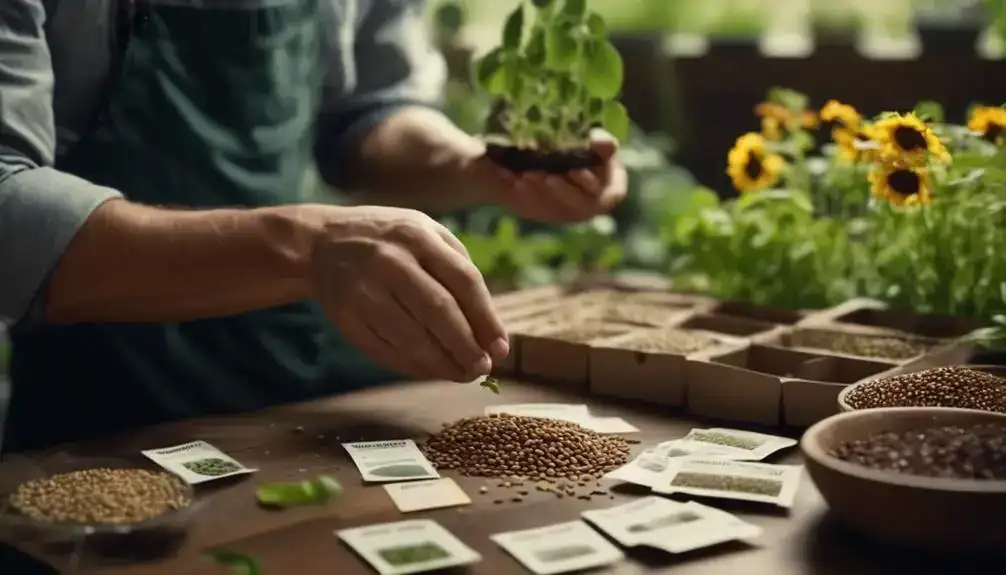So, you’ve decided to grow excelsa, but have you carefully considered the seeds you’re about to plant? Choosing the wrong seeds for your excelsa plants can lead to a host of problems that you’d rather avoid.
From poor germination to weak seedlings, the consequences of improper seed selection can be frustrating. But fear not, by understanding the common mistakes and pitfalls in seed selection, you can set yourself up for success from the very beginning.
Importance of Seed Selection

Selecting high-quality seeds is essential for ensuring a successful and bountiful harvest of Excelsa plants. When choosing seeds for your Excelsa plants, two critical factors to consider are seed viability and genetic diversity.
Seed viability refers to the ability of a seed to germinate and develop into a healthy plant. Ensuring that the seeds you select have high viability is crucial for the successful establishment of your Excelsa crop.
Genetic diversity, on the other hand, is essential for promoting resilience and adaptability within the plant population. By selecting seeds from a diverse range of parent plants, you can enhance the overall vigor and health of your Excelsa crop, making it better equipped to withstand environmental stressors and potential disease threats.
When sourcing seeds for your Excelsa plants, prioritize suppliers who prioritize and maintain high seed viability and genetic diversity in their seed stock. Doing so won’t only contribute to the success of your current harvest but also lay the foundation for future innovation and advancement in Excelsa cultivation.
Identifying Quality Excelsa Seeds
Now let’s talk about what makes Excelsa seeds high quality.
Understanding the factors that contribute to seed quality will help you make informed decisions when choosing seeds.
You should also consider reliable suppliers to ensure you’re getting the best Excelsa seeds for your needs.
Seed Quality Factors
To ensure you are selecting high-quality Excelsa seeds, carefully examine their physical appearance and firmness to identify viable options for planting. When assessing seed quality, factors such as seed storage and seed viability are crucial. Look for seeds that are plump, uniform in size, and free from any damage or discoloration. Additionally, viable seeds should feel firm and heavy for their size, indicating a good moisture content. To further aid in your selection process, consider the following table that outlines key quality factors to look for in Excelsa seeds:
| Quality Factor | Description |
|---|---|
| Physical Appearance | Plump, uniform size, no damage or discoloration |
| Firmness | Seeds should feel firm and heavy for their size |
| Moisture Content | Optimal moisture level crucial for seed viability |
Sourcing Reliable Suppliers
When identifying quality Excelsa seeds, prioritize sourcing reliable suppliers who adhere to stringent quality control measures. Look for suppliers with a proven track record in seed quality assurance. Reliable suppliers often invest in advanced technologies and processes to ensure the purity, viability, and genetic integrity of their seeds. They also provide detailed information about the seed’s origin, including cultivation practices and any treatments applied.
By partnering with such suppliers, you can gain access to high-quality Excelsa seeds that possess the desired traits for innovation and experimentation in your agricultural pursuits.
It’s essential to establish a strong working relationship with these suppliers to stay informed about the latest developments in Excelsa seed quality and to secure a consistent supply of top-tier seeds for your projects.
Common Mistakes in Seed Selection
When choosing seeds for Excelsa, it’s important to avoid common mistakes that can impact the success of your plants.
Ensure you thoroughly check the quality of the seeds, considering factors such as viability and potential for disease.
Also, take into account the specific planting conditions required for Excelsa and thoroughly research your seed sources to ensure you’re getting the best possible options.
Seed Quality Check
Checking the quality of seeds is crucial when selecting the best options for planting Excelsa, as it ensures successful germination and healthy growth. When assessing seed quality, avoid these common mistakes:
- Neglecting Seed Storage Conditions: Failure to consider proper seed storage conditions can lead to decreased viability and germination rates. Ensure seeds are stored in a cool, dry place to maintain their viability.
- Ignoring Seed Viability Tests: Skipping seed viability tests can result in planting non-viable seeds, leading to poor germination. Perform simple viability tests to assess the potential for successful germination.
- Disregarding Seed Health: Overlooking signs of seed damage or disease can compromise the plant’s growth. Thoroughly inspect seeds for any signs of damage or disease before planting.
Planting Conditions Consideration
To ensure successful germination and healthy growth of Excelsa, it’s essential to consider the planting conditions.
Particularly, avoiding common mistakes in seed selection. Planting depth is crucial, as Excelsa seeds should be sown at a depth of about 1/4 inch in well-draining soil.
It’s important to check the soil pH, aiming for a slightly acidic to neutral pH range of 6.0 to 7.0 for optimal growth. Temperature requirements for Excelsa range from 65 to 75°F (18 to 24°C) during the day and slightly cooler at night.
Consistent watering is vital, ensuring the soil is moist but not waterlogged. Additionally, providing adequate light exposure, ideally in a location with partial shade, is important for the successful growth of Excelsa.
Research Seed Sources
Avoid the common mistake of selecting seeds based solely on price or availability; instead, prioritize reputable sources known for providing high-quality Excelsa seeds. When researching seed sources, consider the following:
- Supplier Reputation: Look for suppliers with a proven track record of providing top-quality Excelsa seeds. Check customer reviews and ratings to gauge the supplier’s reliability and customer satisfaction.
- Seed Viability: Ensure that the seeds offered by the supplier have high viability rates. It’s crucial to choose seeds that have been properly stored and are known to germinate successfully.
- Genetic Purity: Select seeds from suppliers that guarantee genetic purity to ensure that the Excelsa plants you grow will exhibit the desired characteristics and traits.
Understanding Seed Propagation Techniques

When selecting seeds for Excelsa, understanding seed propagation techniques is essential for successful cultivation. To ensure you’re starting with the best possible seeds, consider seed viability testing before planting. This process evaluates the germination potential of the seeds, helping you select the most viable ones for propagation.
Additionally, understanding the germination process is crucial. Different seeds have varying germination requirements, so familiarizing yourself with Excelsa’s specific needs will optimize your success.
Proper seed storage is another vital aspect to grasp. Understanding the shelf life of Excelsa seeds and how to maintain their viability is key to preserving their potential for successful propagation. Factors such as moisture, temperature, and light exposure can impact seed longevity.
Tips for Successful Seed Germination
For successful seed germination, ensure that your Excelsa seeds are planted at the correct depth in well-draining soil. Planting the seeds at the appropriate depth is crucial for providing them with the right balance of oxygen, moisture, and stability for successful germination. Additionally, paying attention to temperature requirements and seed storage conditions can greatly impact the germination process.
Here are three tips to help you achieve successful seed germination for your Excelsa seeds:
- Optimal Planting Depth: Plant Excelsa seeds at a depth of approximately 1-2 inches in loose, well-draining soil. This depth provides the seeds with the right environment to establish roots while still allowing them access to the necessary oxygen and moisture.
- Temperature Control: Maintain a consistent temperature range of 70-85°F (21-29°C) for the germination of Excelsa seeds. Fluctuations in temperature can hinder the germination process, so utilizing a stable and controlled environment is essential.
- Proper Seed Storage: Ensure that Excelsa seeds are stored in a cool, dry place before planting. Proper seed storage helps maintain the viability of the seeds, increasing the likelihood of successful germination.
Avoiding Pitfalls in Excelsa Seed Selection
To ensure successful seed selection for Excelsa, pay close attention to the seed’s appearance, weight, and overall condition before planting. Avoid shortcuts by thoroughly evaluating the seeds you choose.
When selecting Excelsa seeds, it’s crucial to prioritize seed viability testing. This step is essential for determining the potential for germination and successful growth. Avoiding shortcuts in this process ensures that you’re planting seeds with the highest likelihood of thriving.
Seed viability testing involves assessing the germination potential of the seeds. This can be done through various methods such as the use of a germination test or assessing the seed’s overall health. By conducting these tests, you can identify seeds that are more likely to sprout, thus increasing your chances of successful cultivation.
Skipping these crucial steps may lead to planting seeds that aren’t viable, resulting in wasted time and effort. By taking the time to carefully select seeds and conducting viability testing, you’re setting the stage for a successful Excelsa cultivation journey.
Conclusion
So, when it comes to choosing the right seeds for excelsa, remember to avoid the pitfalls and mistakes that can hinder successful germination.
Just like a gardener carefully selects the best seeds for a bountiful harvest, take the time to identify quality excelsa seeds and understand the proper propagation techniques.
By doing so, you’ll ensure a flourishing and thriving excelsa plant symbolizing the beauty of nature’s growth and renewal.






